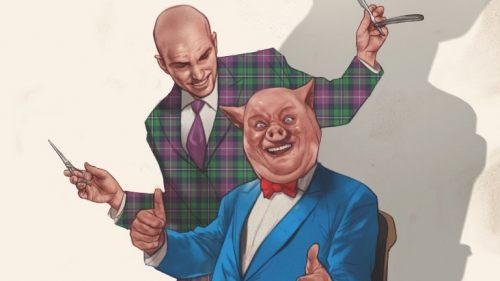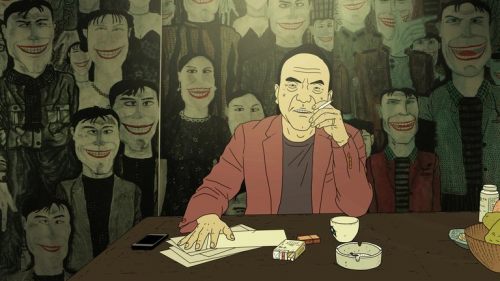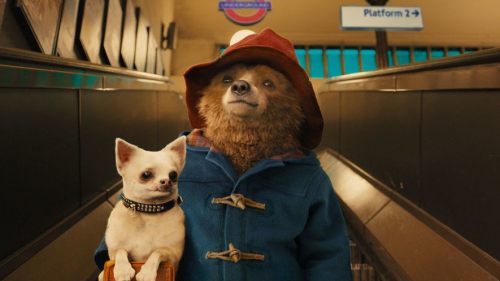TEX AVERY SCREWBALL CLASSICS: Cartoon Pain, Live-Action Laughs
I’ve spent much of my adult life imagining pratfalls and sound effects in everyday life because of cartoons I watched as a child. Little dogs walk to the sound of two high-pitched piano keys. When someone slips, it’s always to the sound of a slide whistle. And if God forbid anyone gets hit on the head, the first sound that fills my ears is of a wooden shillelagh. Tex Avery didn’t do it alone, but his cartoons from the 1940s and ‘50s effectively created this audiovisual lexicon that haunts me still, and clearly I’m not the only one his genius affected. Everything from Who Framed Roger Rabbit to Into the Spider-Verse shows hallmarks of his wild, self-referential, deconstructionist style, and he permanently impacted not only animation but live-action storytelling so thoroughly we’ve forgotten where so many of those elements began.
Previously available only on laserdisc (and more recently in piecemeal form on DVD), Warner Archives’ Tex Avery Screwball Classics: Volume 1 finally showcases the animator’s groundbreaking, adventuresome and massively entertaining work. It’s not only a celebration of a bygone era of animation, but a vivid reminder of Avery’s multigenerational influence, as well as a collection of some really terrific, inventive cartoons that test contemporary boundaries of what’s appropriate for kids but will deliver their parents some nostalgic, knowing laughs.
Avery created dozens upon dozens of animated shorts during his career, and Volume 1 barely scratches the surface of his vast body of work. But personally it would be worth buying just for “Symphony In Slang,” probably my all-time favorite cartoon, presented in restored high-definition Technicolor. A hipster’s account of his life upon arriving at the pearly gates, “Symphony” encapsulates everything that made Avery’s cartoons fun, engaging and unique as he compiles a seemingly nonstop barrage of idioms and turns of phrase that, when presented literally, create some bizarre, vivid imagery. (The shot of “cat got your tongue,” doubled as a callback in heaven, puts me in stitches every time.)
Several of Avery’s cartoons are considered too offensive or problematic today, and understandably so; they depict unflattering stereotypes or otherwise portray behavior - including but not limited to brutal violence - that we appropriately keep kids from seeing. “Red Hot Riding Hood,” one of his most iconic shorts, literally ends with its horny Wolf committing suicide by shooting himself in the head. “Garden Gopher” not only features Spike the bulldog ingesting a cigar in order to smoke out a mischievous varmint, but includes a blackface gag. Thankfully, this collection presents the shorts unedited, offering viewers an opportunity to judge each one for themselves, and to assess how our relationship to certain cultural norms - much less safety boundaries - has changed between then and now. (Past presentation of Avery’s worked edited, redubbed or omitted sequences or even complete shorts.)
But notwithstanding those outdated and sometimes offensive choices, Avery’s gift at creating a gag was simply unparalleled. Never afraid to scuttle the momentum of a scene, or even shot, for a goof, he juggles silly sight gags (in “Red Hot,” a Cigarette Girl sells her wares alongside a taller Girl offering “Longs”) with more complex set-ups, frequently fading to black after a joke pays off. In “Who Killed Who?,” a live-action narrator opens the short, only to turn out to be the murderer at the end. Characters regularly break the fourth wall, and sometimes literally run outside of the animation frame, as in more than one short where they briefly escape past the sprocket holes while chasing an adversary. Screwy Squirrel pummels an adorable counterpart - a more traditional silhouette of a squirrel in the Disney mode - in order to launch his own misadventure with a hound dog he soon learns is as silly as he is. At one point a chase begins to loop because the music starts skipping. And later, he runs off a conventional Red Riding Hood and the wolf chasing her by drawing down the title card of the cartoon like a curtain.
Knowing even a few of the cultural icons of the era in which the shorts were made helps enormously, as female characters frequently speak with accents like Katherine Hepburn’s, for example. “What’s Buzzin Buzzard?” played on food shortages that happened the same year as when the cartoon came out in 1943. In “Batty Baseball,” a billboard bears the face of a Rita Hayworth lookalike. Looking at the shorts now, it’s a reminder how much material slipped by the intended audience - children - as Avery explored his feverish creativity. Double entendres and sly turns of phrase appeal more now for adults even when the physical comedy feels familiar. And often, Avery completely throws a curveball, as at the end of “Batty Baseball,” when a repeated gag culminates in the death of a team catcher - a finale acknowledged with a sign - “Sad Ending, Isn’t it?” that is as shocking as it is funny.
Meanwhile, the juxtaposition of sophisticated artwork and these really frivolous jokes repeatedly showcases how firmly Avery was in his wheelhouse as an animator and storyteller. The opening shots of “Symphony In Slang” shift upwards through dissolves of watercolors towards the heavens, arriving at the gates as Saint Peter records entries to heaven. “The Peachy Cobbler” features one gorgeous image after another of beautifully painted shoes, and the animation is often so good you don’t know from what part of the frame the joke will arrive. Moreover, he gives this wonderful elf’s-eye view of the world in that short which changes the perspective of footwear altogether, while exploring the “personalities” of shoes themselves - how, say, a roller skate is “sporty,” a ballet slipper dainty, and so forth.
Anyone who’s seen his work with the mainstay Looney Tunes characters knows his style - playing with physics, toying with depth and dimension, and bending reality to suit the needs of a good, violent joke. Until critics endeavored to tone cartoons down, fearing that children might duplicate or attempt to copy their animated heroes, his work was the gold standard and blueprint for silly kids storytelling. (Let’s hope this set’s success paves the way for subsequent collections that include material like the wonderful “Little Johnny Jet” and his “…Of Tomorrow” series that parodied instructional films with a madcap onslaught of incredible gags.)
Until then, Screwball Classics: Volume 1 offers an overview of Avery’s work that showcases a handful of characters he created, some instantly iconic and others only intermittently appealing. It’s that wide spectrum of similar but wonderfully different characters that helped define and refine the mechanics of cartoon comedy, for decades to come, as Tex Avery indulged his most devilish impulses to create some absolutely heavenly entertainment.



